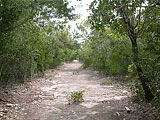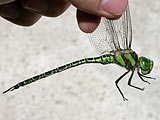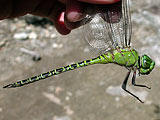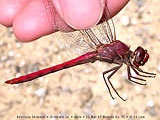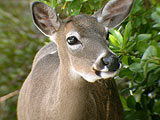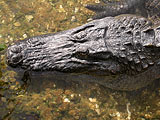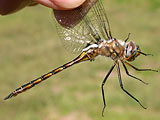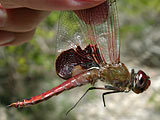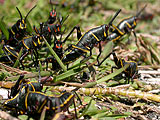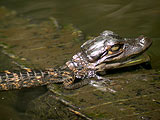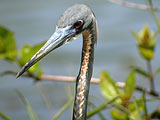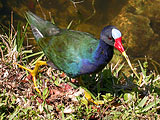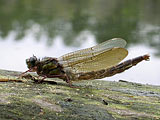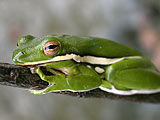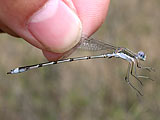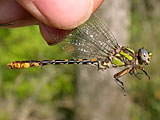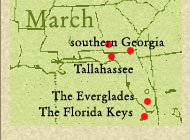
From my snow-lined driveway in southern New York, I began my first dragonfly trip of 2007 on March 20. I drove south 2 full days to reach the southern tip of Florida. On the Florida Keys I would search for a handful of species that barely range into the United States. Jerrell Daigle had been on the Keys two weeks before and had reported Mangrove Darner/ Coryphaeschna viriditas, Antillean Glider/ Tramea insularis, and the Antillean Skimmer, the red Orthemis species that Jerrell was calling schmidti, flying in good numbers.
I wanted to see these species in order to produce the illustrations for my dragonfly guide. Although I could and will work from preserved specimens, I would miss out on their coloration in life. Dragonflies simply do not preserve well, a soak in acetone can preserve the pattern, but the often brilliant coloration (especially of the eyes) of many species just fade away after death. Photographs of live dragonflies can be very useful reference but for many species I have not found photographs that would be good enough to work from. Often the photograph's point of view is not be right for my purposes, and important markings are blocked by wings or obscured by shadows. For many species I have adequate images of one sex but not the other.
The Florida Keys, March 22 - 23
I arrived at Deer Key NWR on Big Pine Key on Mar 22. The first dragonfly I saw was female Seaside Dragonlet at the pond called the Blue Hole. I was hoping for Antillean Glider, as they were here just two weeks before and I had seen a few individuals here on a visit a couple of years ago. But over the two days I spent in the area I did not see any on the pond or in the surrounding woodlands.
I spend quite a bit of time on No Name Key where I did find Mangrove Darners and the red Antillean Skimmer (and saw a number of Key Deer, the tiny endangered subspecies of the White-tailed Deer). The darners were flying up and down the trail through the woods. Females would land and hang up while males tended to remain on the wing and patrol until it got too hot and then they too would perch. Recent rains had created small shallow ponds at low sections of the trail and here I found red Orthemis males perching on vegetation along the edges. Females occasionally arrived to lay eggs in the shallow water, dipping their abdomens while accompanied by interested males.
Species found on the Keys:
Regal Darner/ Coryphaeschna ingens
Mangrove Darner/ Coryphaeschna viriditas
Halloween Pennant/ Celithemis eponina
Red-tailed Pennant/ Brachymesia furcata
Red Saddlebags/ Tramea onusta
Marl Pennant/ Macrodiplax balteata
Great Pondhawk/ Erythemis vesculosa
Seaside Dragonlet/ Erythrodiplax berenice
Antillean Skimmer/ Orthemis sp.
Rambur's Forktail/ Ischnura ramburii
Many thanks to Jerrell Daigle and Anne Morkill, the refuge manager of Deer Key NWR, for facilitating permission to collect at the refuge.
The only other species I collected in south Florida was the Florida Baskettail/ Epitheca stella along the Tamiami Trail. I stopped at a few places but found little of interest as I headed north to meet Jerrell in Tallahassee.
Additional species seen:
Golden-winged Skimmer/ Libellula auripennis (Shark Valley Everglades NP)
Blue Dasher/ Pachydiplax longipennis (Shark Valley Everglades NP)
Eastern Amberwing/ Perithemis tenera (Shark Valley Everglades NP)
Roseate Skimmer/ Orthemis ferruginea (Big Cypress NF)
Four-spotted Pennant/ Brachymesia gravida (Big Cypress NF)
Common Pondhawk/ Erythemis simplicicollis (Brinson Pk, Kissimmee)
Carolina Saddlebags/ Tramea carolina (Brinson Pk, Kissimmee)
Hyacinth Glider/ Miathyria marcella (Lk. Bessie, Orlando)
Black Saddlebags/ Tramea lacerata
Prince Baskettail/ Epitheca princeps
Florida Bluet/ Enallagma pollutum
Tallahassee, March 26 - 27
I had visited Tallahassee just last year at about the same date so I did not need to chase some of the early season specialities of the area like Say's Spiketail or Taper-tailed Darner. I did again see plenty of Gomphus cavillaris brimleyi, the dark subspecies of the Sandhill Clubtail. My main target was the Florida Cruiser/ Didymops floridensis, the larger, somewhat grayer cousin of the much more widespread Stream Cruiser/ Didymops transversa. On Monday we checked a number of beautiful sandy ponds and lakes but saw no Cruisers at all. Along the sandy pond edges, we saw the larval tracks of Belle's Sanddragon, Progomphus bellei, a species I'll need to come back for. It was also still too early for Sepia Baskettail. We tried a couple of just perfect streams for another target, Arigomphus pallidus, the Gray-green Clubtail but again found none. Our only accomplishment of the first day was a female specimen of Clearlake Clubtail, Gomphus australis. I captured a male of this species last year.
Not particularly hopeful, we tried another pair of lakes on Tuesday for the Florida Cruiser. It was still fairly cool when we arrived but almost immediately we could see large dragonflies flying over the water. Males were easy to catch as they patrolled quite unwarily along the edges of the lake. Females were another matter. When they appeared they raced about at high speed usually with a male in pursuit, dipping and swirling madly while skimming low over the water. Luckily they preferred to oviposit in shallow waters where sand was exposed at the bottom so you could at least know where to wait for a chance to swing the net. Eventually my patience was rewarded.
Species seen in Tallahassee area:
Stream Cruiser/ Didymops transversa
Florida Cruiser/ Didymops floridensis
Harlequin Darner/ Gomphaeschna furcillata
Regal Darner/ Coryphaeschna ingens
Cyrano Darner/ Nasiaeschna pentacantha
Common Baskettail/ Epitheca cynosura
Slender Baskettail/ Epitheca costalis
Sandhill Clubtail/ Gomphus cavillaris brimleyi
Ornate Pennant/ Celithemis ornata
Blue Corporal/ Ladona deplanata
Sandhill Bluet/ Enallagma davisi
Cherry Bluet/ Enallagma concisum
Atlantic Bluet/ Enallagma doubledayi
Southern Sprite/ Nehalennia integricollis
Southern Georgia, March 28 - 31
The final leg of the trip was through southern Georgia. I did not have any species targeted but I did want to look at the Snaketail species Giff Beaton had found in 2005 which may or may not be Southern Snaketail, Ophiogomphus australis. I met up with Giff and Steve Krotzer in Douglas, GA where we were first going to look for Say's Spiketail which proved unsuccessful. However they also wanted to try a location where only a couple days previously Marion Dobbs photographed a clubtail that Giff and Steve were convinced was a Sandhill Clubtail, Gomphus cavillaris. They were excited as this would be new species for Georgia and I was interested in seeing it because it seemed to be the paler, browner subspecies G. cavillaris cavillaris which I had not seen in contrast to the G. cavillaris brimleyi I had just seen in Tallahassee. We found the sandy pond where southeastern Georgia extends a little finger into Florida and sure enough confirmed the new state record. Steve dredged for larvae and came up with Progomphus larvae that turned out to be alachuensis, Tawny Sanddragon, also a new species for Georgia.
The next day we traveled west clear across the state, stopping occasionally at stream and river crossings but finding very few adult odonates.
Friday, March 30th was designated Ophio Day as Jerrell and Marion joined us in the southwestern corner of the state to try to more adults of Georgia's mystery Snaketail. The day started drearily with clouds and cool temperatures and very little was flying at the Nature Conservancy property in Early County. It wasn't until mid-afternoon when the clouds parted and the temperature rose quickly. However along the first stream we worked we still could not find any Snaketails. We drove to a second area where adults have been collected in previous years and almost immediately out of the car I spotted a female in the vegetation. I waited very patiently while Steve and Giff took turns photographing her before I netted her. Males were a little more difficult on this day but they seemed easier to find as the afternoon wore on. Now if we can only figure out what they are.
We said our goodbyes on the 31st but before we parted Giff and I tried a couple of streams hoping for Sundragons/ Helocordulias but the weather was again cloudy and cool. The sun may have re-emerged in the afternoon but I decided to head home. I harbored the fantasy of driving all the way to New York that night. The GPS estimated my arrival time at 4:AM but I was exhausted by 10:PM and reluctantly stopped over in chilly northern Virginia. I got home about 1:30 PM on Sunday, April 1, the gray Prius logging 3714 miles on the long dragonfly road.
Additional species seen in GA:
Common Green Darner/ Anax junius
Comet Darner/ Anax longipes
Springtime Darner/ Basiaeschna janata
Twin-spotted Spiketail/ Cordulegaster maculata
Brown Spiketail/ Cordulegaster bilineata
Cypress Clubtail/ Gomphus minutus
Calico Pennant/ Celithemis elisa
Common Whitetail/ Plathemis lydia
Painted Skimmer/ Libellula semifasciata
Little Blue Dragonlet/ Erythrodiplax minuscula
Mantled Baskettail/ Epitheca semiaequea
Ebony Jewelwing/ Calopteryx maculata
Southern Spreadwing/ Lestes australis
Variable Dancer/ Argia fumipennis fumipennis
Orange Bluet/ Enallagma signatum
Vesper Bluet/ Enallagma vesperum
Lilypad Forktail/ Ischnura kellicotti
Citrine Forktail/ Ischnura hastata
Fragile Forktail/ Ischnura posita
